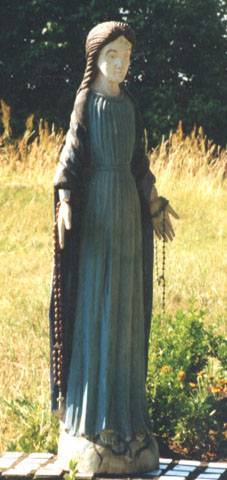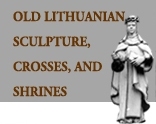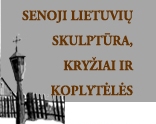THE SAMOGITIAN FOLK
SCULPTURES
by Skaidre
Urboniene
- One of the most expressive branches of Lithuanian
national art was sculpture. Statuettes of saints were created by
the rural self-taught masters called „god markers”. Those
statuettes were mostly placed into monuments of small-scale
architecture: chapels, roofed, pillars with a miniature chapels,
crosses. In different regions of Lithuania those monuments had the
specific features, stylistics of sculptures was different as well.

- Majority of traditional national sculptures kept
in museums are dated of the 19 th - the first half of the 20th
century. There are only several statuettes dated to the 18th
century in museums. Archival materials provide information about
god-markers also mostly from the middle of the 19 th - the first
half of the 20 century. So the themes and features of the
Samogitian folk sculpture of the 19 th - the first half of the 20
th century are generalized and discussed in the present article.
- Monuments used to be erected in farmsteads, by
the wayside, at crossroads, on river banks, in cemeteries,
churchyards, streets and squares of towns and villages and other
places related to some remarkable events.
- A height of Samogitians pillars with a chapel
reached 2-4 meters. There were various constructions of chapels:
opened from one or four sides, one - or two-storied, with
perpendicular or sloping walls, their roofs were double - or four
- pitch, of bent structure, cross like connected.
- Each monument of small - scale architecture was
erected on certain occasions the reasons of which varied: related
with personal or family life and economic activity, with secular
or religious activity of a village community or its part, with
separate events of life of population or the whole nation
especially within the crucial historical moments.
- The large part of the first group monuments
marked burial places in the cemeteries. The monuments were built
on a place of tragic death as well - „that soul lost would
peacefully rest and did not frighten passers-by”. The crosses,
chapels marked the dates of weddings, births or christenings. They
were erected in expectation of a baby and not getting him or in
case of its death. In their farmstead’s monuments Samogitians
loved to have statuettes of the saints named after members of the
family. Monuments used to be built asking for health or in
gratitude for treatment, for protection against misfortunes or
poor harvest, or cattle-plague, in case of house-warming or
departure to new place.
- The reasons of erection of monuments of village
community or its part were similar: desire of health and success
in economic activity, desire to avoid misfortune, for
commemoration of the important events in the village life. The
village youth often built monuments in Whitsunday.
- The third group of monuments is related to the
events of life of certain population or the whole nation,
especially within the crucial moments. The erected monument had to
be consecrated. The unconsecrated monument was marked by the
bouquets of flowers, junipers, fir-tree branches. That bouquet
could be removed only after consecration.
- The small statuettes of 15-70 cm height were put
inside miniature chapels or pillars with chapel. Large size
sculptures were put inside ground-built chapels. Height of such
sculptures reached 1 meter and sometimes more. The higher statues
(170-200 cm) are found in altars of the churches.
- All statuettes are colored. Polychrome
supplements the form, adds new element of decoration, makes clear
or changes the expression of faces.
- Themes related to Jesus Christ and Virgin m Mary
prevail in Samogitian sculpture. Statuettes of men-saints (St.
John Nepomuk, St. George, St. Roch, St. John the Baptist, St.
Isidore etc.) constitute large part of sculpture, while
women-saints (St. Barbara, St. Ann, St. Agatha etc.) considerably
smaller part. Themes of saints were taken from ecclesiastical
iconography, but they were interpreted according to the god-maker’s
wish. But in spite of rather free interpretation of themes,
masters tried to adhere to exact iconographical attributes as a
main factor of recognizing the certain theme.
- Monuments with statuettes of saints reflected
religious conception, the world outlook, ethical and aesthetical
views of common people.
|

